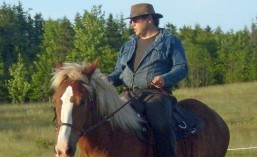For the past several weeks, I have been engrossed in harvesting our annual venison. Nova Scotia has plentiful deer except on the isle of Cape Breton due to irresponsible logging that destroys their habitat. This year, two deer were allowed in the region of Twa Corbies Hollow. By applying tracking skills, I took both deer within days of the opening of the season. One of the deer was typical, the other was exceptionally huge–one of the largest bucks taken this year. It did not have the biggest rack, but I do not hunt for trophies, I hunt for meat. It was phenomenally large and yielded over 200 lbs of venison once dressed out. In both cases, taking each whitetail was fairly straightforward. I scouted until I found an area that was populated with deer spoor and waited for the deer to come to me. Of course, that requires having tracking skill and knowing how to evade detection by those animals.

The track of an enormous buck that I stumbled across in early September, tracked down to his home territory, and took a week after the season opened.
The second deer–the enormous one–required a bit more effort. One day while out hiking, I spotted an enormous track. I could tell it was fresh, and by the size that the deer that made it was exceptionally large: at least 300 lbs. Applying principles of tracking and animal behavior, I was able to deduce the likely territory of this massive buck. It kept to regions of the homestead we call the East Glade where long ago cut-back woods have yielded wild grassy meadows. The East glade borders the cultivated meadows around the cottage to the west and old forest on the east. Brooks and ponds can be found at the east and west sides and at the edge of the Old Wood. Deer require all kinds of browse and habitat, so they tend to keep long, narrow territories in order to get into a variety of terrains, so I scouted through the likely area of its territory until I found a place where deer trails were so established they were like ruts in the Earth. There I found abundant droppings and more tracks of this massive buck. Where they were most concentrated and fresh, I knew I had found one of his regular routes.
Further applying tracking skills, I located a site 175 yards away in a region concealed by shadows of young spruces behind rock, where scrub would effectively break up my outline and the prevailing wind was typically downwind of the site I anticipated the deer to appear. Seven days later, he appeared exactly at the spot I anticipated and with no idea I was there, he was calm and presented an easy target.
The ability to track has made me almost 100% successful in my hunts and wildlife observation for more than twenty years. I feel tracking is an essential skill of both bushcrafters and homesteaders, whether your goal is to observe wildlife, study their movements and diets, keep predators away from livestock or hunt food. It is also one of the most challenging skills to acquire.
In spring of 2014, Twa Corbies will offer an introduction to tracking. Participants will learn to recognize various spoor: tracks, trails, various droppings and indicators such as kill sites and old den markers. Students will also learn how to age spoor and the challenges to doing this accurately. Students will receive an introduction into the behavior of wildlife and how to apply such knowledge to the interpretation of spoor. Just click on the link to learn more!



Pingback: Black tail Hunting | My Blog